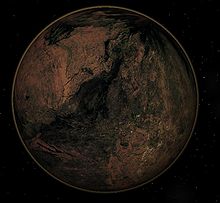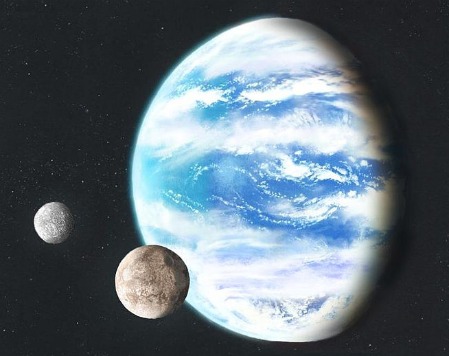Astronomers have found many exotic exo-planet since the first Hot Jupiter was inferred in 1995 roasting in a tight orbit around the very sun-like star 51 Pegasus. Since then speculation and some preliminary indication of water worlds, methane planets, gas dwarfs and super earths has become regular fare. Another possible composition dreamed up by planetary scientists is a carbon world, usually presented as a dismal black and sooty planet like the one below.
But carbon forms another stable structure under enough pressure and scientists have found a planet that just might fit that glittering bill:

A hypothetical carbon planet, covered with organic 'soil' over a carbon-diamond crust. Image from the Wiki
In addition, “we are very confident it has a density about 18 times that of water,” said study leader Matthew Bailes, an astronomer at the Swinburne Centre for Astrophysics & Supercomputing in Melbourne, Australia. “This means it can’t be made of gases like hydrogen and helium like most stars but [must be made of] heavier elements like carbon and oxygen, making it most likely crystalline in nature, like a diamond.”
The weird object is 4000 light-years away and estimated five times the size of earth. The density is the real giveaway: this object is 18 times heavier than water.
Moreover, it circles a neutron star. Neutron stars are the corpse of massive stars that blew up, leaving a tiny core of degenerate matter weighing thousands to millions of tons per cubic inch often spinning wildly. It’s far from clear exactly how the world ended up orbiting such an unusual partner. One possibility is the original system was a binary and the companion a red-dwarf star which was denuded of its gaseous envelope in the ancient super nova, leaving behind a core of carbon and oxygen (Not sure exactly how that would work, see comment by Amphiox below). Or the object could have grown out of the heavy element rich nebula formed by a large exploding star similar to the way scientists believe traditional planets form out of the material surrounding young stars.
Whatever it is, or however it came to be, I say we call it Diamondus.


You’re wrong about one thing: we should call it Midnight.
I’m voting for “Dustin.”
I vote for something memorable like G632-X98.
How would this come about? Red Dwarf stars aren’t massive enough to fuse beyond helium in their cores (or so I always thought), meaning their cores should be made of helium. Unless they started out with carbon and oxygen from the start, but would that realistically have been enough to make a core this big?
Good question Amphiox! I threw that in there because there was some speculation about that in some of the articles on the subject. But nw that you mention it, yeah, I’m not sure how that would work.
BTW, working on a hypothetical image for such a world. I assumed the atmosphere would be blasted mostly away by hard radiation, but really did that because there would be no “scenary” from the surface if a planet like that had the kind of atmosphere one would associate with a mass many times that of earth.
Holy cra…! How did THAT blockquote get into my post? Is my computer possessed by the zombie ghosts of prior quotations cut and pasted?
Dunno man. I’ve had some weirdness with blockquotes myself.
I found on another blog mention of a hypothesis that this is the remnant core not of a red dwarf, but actually a sun-sized star, which would account for the carbon.